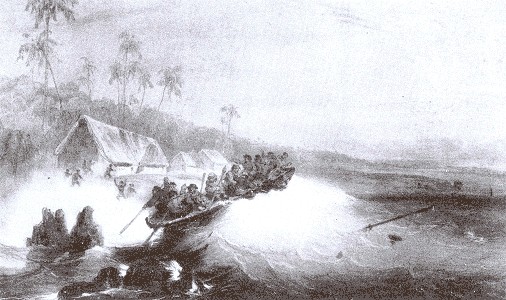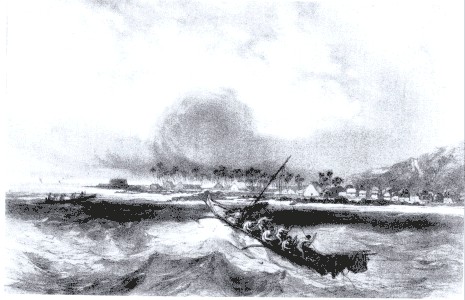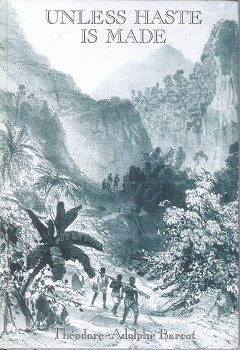 |
surfresearch.com.au
barrot : kealakeakua, hawaii, 1936 |
| home | catalogue | history | references | appendix |
|
 |
Illustration by
|
Page 1 (?)
Leaving Guayaquil,
August 14th, 1836, we came in sight of Hawaii in the night of September
29th. From early morning we looked with impatience, in the direction where
we supposed the island would appear.
According to
the accounts of navigators, we ought, at a great distance, to perceive
Mauna Loa, the mysterious summit of which had not, for a long time, been
visited by any European.
It entered into
our plans to explore its almost inaccessible gorges, to cross over the
snows which crown it, and inscribe our names upon its most elevated peak;
this for some days was the almost constant subject of our conversation.
Page 11
CHAPTER TWO
The house of Mr.
Forbes is in the midst of a garden, which seemed to have been somewhat
neglected, and surrounded by a quick-set hedge of ki; the ki is
a shrub with large leaves, and its root when cooked has the taste of calomel
or burnt sugar.
The natives formerly
extracted a very strong liquor from it, but at present the missionaries
have prohibited, under severe penalties, the distillation of this root.
Mr. Forbes received
us very cordially, and introduced us to his family, consisting of his wife,
a native like himself, of the United States, and two lovely children.
Kapiolani joined
us and very soon the bell called us to church.
...
Page 13 (Sunday With Missionaries)
On the morrow,
I went to visit the village of Kealakeakua, accompanied by M. Eydoux, surgeon
of the corvette, and M. Hebert.
To land with
dry feet was impossible, and we were obliged to swim in some manner in
order to reach the shore.
This failed not
to excite the mirthfulness of the population around us.
It is certain
that the customs of the country were much better adapted to the occasion
than our own. A crowd of boys and girls immediately surrounded us.
Although ...
Page 14
... scarcely two
miles distant from Kaawaloa, the population of Kealakeakua appeared to
be far less under the influence of the missionary.
We could perceive
this without difficulty in the clothing of the islanders and in their conduct
to",,!ards us.
Here the maro
was the only article of clothing worn by the men, and scarcely were the
women better clad.
But the manner
in which the women received us proved beyond a doubt, that their actions
were not so immediately under the control of Mr. and Mrs. Forbes as those
of the inhabitants of Kaawaloa. They employed every possible art to attract
our attention and to win our favor; but it is true that the rings and necklaces
distributed by these gentlemen to the prettiest, were not without influence
upon their friendly dispositions.
The itch seemed
to be a prevailing malady among them, almost all were more or less affected
with it. This circumstance, joined to the copper color of their skin and
to the sluttishness of their clothing, diminished very much the strength
of their attractions.
As the men that
we had seen up to that time seemed tohave a preference for money and clothing,
so the women at Kealakeakua appeared to have preserved the taste for toys
noticed by the first navigators.
A string of glass
beads, a copper ring with a colored stone, filled them with joy.
Towards noon,
the entire female population of Kealakeakua assembled to bathe in a small
bay
surrounded by
lava rocks; one rock served the bathers for a screen, and they plunged
thence entirely naked, into ...
Page 15 (The People of Kealakeakua)
... the waves
which were breaking upon the shore; a plank, six or eight feet in length,
and pointed at one end, enabled them to sustain themselves on the crest
of the waves.
It was indeed,
a singular picture- a swarm of young women passing far out to sea, then
returning with the swiftness of an arrow, borne upon the foaming crest
of the surges which break with the noise of thunder on each side of the
bay.
I expected every
moment to see them dashed against the sharp points of the rocks, but they
avoided the danger with surprising address; indeed, danger seemed to delight
them, and they dared to defy it with a courage which astonished me. (#)
The least movement
of their body gave to the plank which sustained them, the desired direction,
and disappearing for a moment in the midst of the breakers, they very soon
arose from the foam and returned at their ease to run the same race again.
I saw a mother,
who having placed her child, scarcely a year old, upon a plank two feet
long, pushed it before her to a great distance, and then abandoning it
to the fury of the waves, she followed, directing only now and then the
plank which sustained it.
I had expected to see this population such as Capt. Cook found it, free and independent, and the contrast I avow, did not appear to me in favor of the present, when I afterwards saw these women covered with dirty rags.
The difficulties
we had experienced in landing suggested the idea of returning on board
the Bonite in a canoe.
We had been able
to appreciate during the day, ...
Page 16
the advantages
possessed by these light and easily worked canoes in a rough sea over our
heavy boats.
We entered a
canoe of about fifteen feet in length and a foot or more in width.
This canoe, like
all those of the Pacific islands, had an out-rigger made of a piece of
light wood and fixed parallel to the canoe by means of two transverse bars
four or five feet in length.
Our Indians waited
for what is called a calm, that is the moment when the waves which
usually succeed one another to the number of four or five, seem to cease
for an instant, then they drew the canoe rapidly some distance from the
shore, when springing upon their seats and paddling vigorously they were
able before the next wave rolled in to gain such a distance that we experienced
only two or three strong undulations.
We reached the
Bonite safe and sound.
The next day I
spoke to Mr. Forbes concerning the extraordinary dexterity in swimming
which I had observed on the preceding day among the natives.
"You can have
no adequate idea of it," he replied, "they are more at their ease in the
water than on the land."
To confirm this
assertion, he related an adventure which seemed too interesting to be omitted
here.
The natives in
their canoes frequently pass over the channels which separate the different
islands of the archipelago.
One day, a native
accompanied by his wife and two small children, put off in a canoe from
the northern point of Lanai with the design of landing on the southern
part of Molokai, a distance of seven. or eight leagues.
When he had put
to sea the weather was ...
Page 17 (Tale Of Tragedy At Sea)
... fine, but
suddenly a dark cloud blackened the sky, a gale commenced and the sea became
very rough.
For a long time
the skill with which the islander guided his frail skiff in the midst of
the waves preserved it from being wrecked; but at length a sea broke the
out-rigger and the canoe capsized. The children were too young to be able
to swim.
He seized them
at the moment when the sea was about to swallow them up, and placed them
upon the canoe, which being made of light wood floated, although bottom
up.
Then he and his
wife swimming at its side, undertook to urge it along to the nearest shore.
They were then
near the middle of the channel.
After many hours
of fatiguing exertion, and when they had almost reached the shore, they
met a
very strong current
which urged them back into the open sea.
To struggle against
the force of the current would have been to expose themselves to certain
death; they therefore decided to direct their canoe towards another part
of the island.
Yet the night
came on and they began to feel cold.
The woman was
the first to complain of fatigue, but the desire so natural to escape death,
and the sight of her children whose life depended upon the preservation
of her own, gave her courage, and
she continued
to swim near her husband, pushing the canoe before them.
Soon the poor
children became fatigued for they could not long cling to the round and
polished surface of the canoe without a continued effort, and they were
also chilled with cold.
Soon they relinquished
their hold, and fell one after the other, into the sea.
Their parents
seized them and placed ...
Page 18
... them again
upon the canoe, striving at the same time to encourage them.
Alas! their strength
was exhausted- their little hands could no longer retain their grasp, and
the sea engulfed them for the third time.
It was no longer
necessary to think of preserving the canoe; the parents therefore took
the children upon their backs and swam towards the land which was sarcely
visible in the darkness.
An hour later,
the woman discovered that the child which she was carrying was dead, and
she broke forth into bitter lamentations.
In vain did her
husband persuade her to abandon the child and to take courage, pointing
out to her the shore which now seemed near.
The unhappy mother
would not separate from her lifeless child, and she continued to carry
her precious burden until she felt her strength nearly exhausted, when
she told her husband that she must die, for she could swim no further;
yet, notwithstanding her husband's earnest entreaties, she would not relinquish
her burden.
He then endeavored
to sustain her with one hand and to swim with the other, but nature could
not prolong the struggle, and she disappeared beneath the waves.
The husband continued
to swim on in sadness.
The desire to
save his surviving child alone sustained him.
At length, after
many hours of unspeakable hardship, and when almost dead, he reached the
shore. His first care was to embrace the son he had saved, for he alone
remained to him of his beloved family.
But on taking
him into his arms, he perceived that he was dead, and he fell senseless
upon the sand. He was discovered at day-break lying prostrate on the ...
Page 19 (Missionary Characterzies Kapiolani)
... shore by some
fishermen.
He revived, but
he died soon after in consequence of his sufferings, and perhaps also from
grief.
He had been in
the water eighteen hours.
We were at Kealakeakua
six days, visiting the natives at their houses and collecting such information
as seemed to posess any interest.
We were informed
that Kapiolani together with Kaahumanu, wife of Kamehameha, was the first
to embrace the Christian religion, but her conversion was not very sincere
at first.
"For twelve years
or more," said Mr. Forbes, "she was a very bad woman. She was constantly
drunk and she had four or five husbands. Even after having received baptism,
she retained two; and it was only in consequence of our expostulations
that she came to the conclusion to have but one."
At present she
is a virtuous woman, and she has become the firmest defender of the moral
and religious innovations on Hawaii.
Page ? (Opposite
Chapter Four)
 |
Illustration by
|
 |
Unless Haste is Made: A French Skeptic's Account of the Sandwich Islands in 1836. Illustrated by Barthelme Lauvergune and Theodore Auguste Fisquet. Press Pacifica, Kailua, Hawaii, 1978. Penny Pagliaro (Editor), Daniel Dole (Translator). Introduction by Arthur Nagasawa. |

| home | catalogue | history | references | appendix |